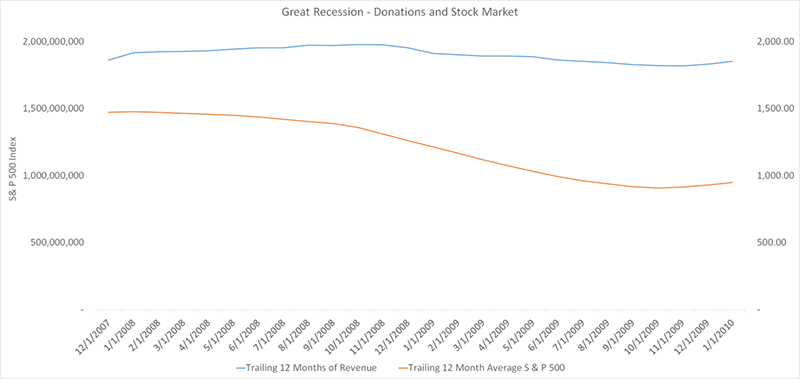Charitable Giving in Times of Fear and Uncertainty
Analysis of charitable giving during the Great Recession shows nonprofits can survive these unsettling times—and even prosper.
As the wave of closures for many public gatherings gain steam—think schools, bars and restaurants shutting down—your favorite local and national nonprofits are being affected no differently.
Already, thousands of nonprofit fundraising events have been delayed or outright canceled. Combined with the bear stock market, the current crisis is striking fear into nonprofit boards, staff and fundraisers everywhere.
After all, since nonprofits rely on special events and donors with large stock portfolios, surely giving will suffer too?
“Not so fast,” says Ben Miller, chief analytic officer of DonorTrends and secretary of the Growth in Giving Initiative, a program of the Association of Fundraising Professionals. “If we look at what happened during the Great Recession, giving to nonprofits remained steady, with only slight declines over the entire period.”

The S&P 500 (average, trailing 12 months) compared to donations received by nonprofits in Growth in Giving Database in the same time period during the Great Recession. Despite the rapid collapse of the S&P 500 of nearly 39 percent, giving to nonprofits rose slightly and then declined by only 8 percent at the end of the recession.
This new analysis is based on a subset of nonprofits which make up the Growth in Giving Database, the world's largest publicly available database of actual nonprofit gift transactions. The subset contains information from 2,543 small- and medium-sized nonprofit organizations and represents the best historical record of giving during that tumultuous time.
Miller continued, “While we have to be careful because it is not a true apples-to-apples comparison to today’s headlines and the concept of ‘social distancing,’ the data does suggest that donors are very supportive of their nonprofits through uncertain economic times.”
What Nonprofits and Donors Can Do
The first thing is for fundraisers and boards not to panic. Like the Great Recession, it’s likely that the current situation will pass. And donors still want to make a difference and be in control. For the same reason that hoarding toilet paper allows people to have some control over the current situation, so too can donors take control and help their favorite nonprofit.
This means allowing online donations and, in lieu of in-person fundraising events, holding virtual ones instead. Or switch to other fundraising campaigns, such as monthly giving, which provides steady and predictable cash flow, especially in times like today.
Miller concluded, “When the current crisis ends, history will show that the most successful nonprofits continued to ask for donations, although likely in a different way. Those nonprofits who go ‘silent’ or attempt to give their donors a break will likely see the same results as others before them—and suffer or even go out of business as a result.”
The data analysis includes giving details from 2,543 small- to medium-sized nonprofit organizations based in the US as a subset of the Fundraising Effectiveness Project. The distribution of NTEE codes (a way to organize nonprofits by industry type) for the 2,543 organizations is comparable to the sector-wide distribution. For more information about the Growth in Giving Initiative and Fundraising Effectiveness Project, please visit The Fundraising Effectiveness Project.
The Fundraising Effectiveness Project (first established in 2006) and the Growth in Giving Database (created in 2012) are both administered by the Association of Fundraising Professionals. The Growth in Giving Database is the world’s largest public record of donation activity, with more than 204 million donation transactions, and is continuously updated by leading fundraising software thought leaders (in alphabetical order) Bloomerang, DonorPerfect and NeonCRM. Additional partners include the 7th Day Adventists, The Biedermann Group, DataLake Nonprofit Research, and DonorTrends (a division of EveryAction). For more information and how you and your fundraising software provider can participate, please visit The Fundraising Effectiveness Project.